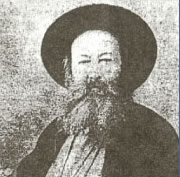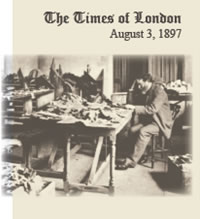The Cairo Genizah
 he Cairo Genizah, mostly discovered late in the nineteenth century but still resurfacing in our own day, is a collection of over 200,000 fragmentary Jewish texts (which may well equal three times that number of folios). Many of these were stored in the loft of the ancient Ben Ezra Synagogue in Fustat medieval Cairo, to the south-west of the modern city) between the 11th and 19th centuries. A genizah is a storage room where copies of respected texts with scribal errors or physical damaged, or unusable documents, are kept until they can be ritually buried. The dark, sealed, room in the arid Egyptian climate contributed to the preservation of the documents, the earliest of which may go back to the eighth and ninth centuries.
he Cairo Genizah, mostly discovered late in the nineteenth century but still resurfacing in our own day, is a collection of over 200,000 fragmentary Jewish texts (which may well equal three times that number of folios). Many of these were stored in the loft of the ancient Ben Ezra Synagogue in Fustat medieval Cairo, to the south-west of the modern city) between the 11th and 19th centuries. A genizah is a storage room where copies of respected texts with scribal errors or physical damaged, or unusable documents, are kept until they can be ritually buried. The dark, sealed, room in the arid Egyptian climate contributed to the preservation of the documents, the earliest of which may go back to the eighth and ninth centuries.
These manuscripts outline a 1,000-year continuum of Middle-Eastern history and comprise the largest and most diverse collection of medieval manuscripts in the world. The Genizah can be described as one of the greatest Jewish treasures ever found.
Discovery
Early visitors to the Genizah were wary of examining its contents because of the local superstition that foretold disaster for anyone who might remove any of its contents. This, too, contributed to the preservation of the documents.
In the second half of the 19th century some texts were sold by synagogue officials to dealers, scholars and visitors. Famous libraries in St. Petersburg, Paris,
London, Oxford, Cambridge and Philadelphia acquired major collections.
In the early 1890's Rabbi Shlomo Aharon Wertheimer, a Torah scholar, collector and researcher, living in Jerusalem, began publishing manuscripts that he had purchased from the Cairo Genizah with his identifications and explanations – among them rare and important texts. He also sold some of these manuscripts to collectors in order to finance the purchase of additional ones. To some extent, he was one of the first to recognize the treasure trove that was the Cairo Genizah.

However, it was only in late 1896 and early 1897, that the entire treasure trove of the Genizah was finally revealed. Dr. Solomon Schechter, who at the time was a reader in Talmudic studies at the University of Cambridge, had earlier in 1896 been shown some rare precious leaves of two ancient Jewish literary works. Dr. Schechter's efforts to find their origins led him to Cairo, to the Ben Ezra synagogue, where, with communal assistance, he found the legendary Genizah hidden in a sealed room on its roof. His trip was funded and formally sponsored by the Master of St John’s College in the University of Cambridge, Dr. Charles Taylor.
After obtaining the permission of the synagogue officials to empty the Genizah, Schechter, shipped the bulk of the Genizah's contents (over 140,000 documents) to Cambridge for further research. Five years later, Schechter moved to New York as the newly appointed president of the Jewish Theological Seminary, bringing a small number of the manuscripts with him.
More than a century later, this huge worldwide archive is still being identified and cataloged.

[The Cairo Genizah] is a battle field of books, and the literary productions of many centuries had their share in the battle.... Some of the belligerents have perished outright, and are literally ground to dust in the terrible struggle for space, whilst others...are squeezed into big, unshapely lumps."
Solomon Schechter,
Cambridge University
Contents of the Genizah
"The Genizah texts are written in various languages especially Hebrew, Arabic and Aramaic mainly on vellum and paper, but also on papyrus and cloth. They represent the most important discovery of new material for every aspect of scientific Hebrew and Jewish studies in the Middle Ages. As a result of the conservation, decipherment and description done for over a century, but particularly in recent years and at Cambridge, previous ignorance has been dispelled and theories drastically modified. Among the subjects that have benefited substantially are the emergence of Hebrew grammatical systems; the development of synagogal lectionaries and of translations and interpretations of the Hebrew Bible; and the literary history of such sectarian works as the Damascus Document and Ben Sira. Major impacts have also been made on the textual and exegetical study of Talmudic, Midrashic, liturgical and poetic literature, and on the evolution of Jewish religious law. Knowledge and understanding of Karaism, of Fatimid Egypt and Crusader Palestine, of special Jewish languages such as Judaeo-Arabic, and of daily activities in the Mediterranean area have also expanded greatly."
[Professor Stefan Reif; The Cairo Genizah: a Medieval Mediterranean deposit and a modern Cambridge Archive, 66th IFLA Council and General Conference]
In addition to containing Jewish religious texts such as Biblical, Talmudic and later Rabbinic works (some in the original hands of the authors), the Genizah gives a detailed picture of the economic and cultural life of the North African and Eastern Mediterranean regions, especially during the 10th to 13th centuries. Its documents reveal a wealth of information about this previously little known period in Jewish history. Documents describe the relations between the members of the three major religions of the time – Christianity, Islam and Judaism – and the vital role the Jews played in the economic and cultural life of the medieval Middle East. Among the documents are community notes, leases, marriage contracts, and private letters, as well as legal and financial items.
The Genizah "acquaints" us with many unknown individuals as well as providing new information about well-known personalities. Among the latter are the renowned poet and thinker, Rabbi Yehuda Halevi, and Rabbi Moses ben Maimon (Maimonides), the famous medieval Jewish philosopher and royal physician.
Since Cairo was politically and geographically central in the Islamic world of the day, the Genizah contains documents from near and far. A letter describing the Khazar kingdom's conversion to Judaism in about the eighth or ninth century is also included among the precious documents. A letter from Kiev from the tenth century provides the earliest evidence of a Jewish community existing in the Ukraine. Also included is a large archive of medieval Hebrew poetry from Provence and Spain, written by members of the large Spanish Jewish community some remnants of which arrived in Egypt following the 1492 Expulsion. Yiddish letters and poems from the 14th to 16th centuries are included as well.
The Genizah Today
Today, a large portion of the Genizah's documents are available at Cambridge University Library and at the Jewish Theological Seminary in New York. Smaller collections are spread out in university library collections across the globe, among them London, Oxford, Manchester, Paris, Geneva, Vienna, Budapest, St Petersburg, New York, Philadelphia, Washington and Jerusalem; some are housed in private collections.
In a historic move, The Friedberg Genizah Project, is digitizing the entire corpus of manuscripts discovered in the Genizah, together with all relevant data, such as catalog entries, bibliographical references, translations, transcriptions and citations, and making it available to the world of learning. In addition, a powerful search engine is included on the site allowing scholars to navigate the massive data base. Thanks to this website, Genizah research has received a powerful boost around the world. The Genizah is a window on nearly 1,000 years of Jewish and Middle Eastern history, scholarship and daily life. The FGP will open this window wider than ever before, launching an exciting new stage in Genizah scholarship.
Sources
http://www.jewishvirtuallibrary.org/jsource/History/Genizah.html
http://www.bbc.co.uk/dna/h2g2/A10358868
http://www.ifla.org/IV/ifla66/papers/058-145e.htm